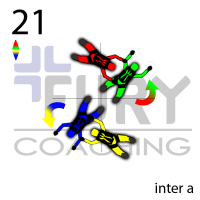How to Close Any Block
Monday, November 2, 2020

Closing a block means landing on or catching the grips after the inter is performed. In the context of individual turns, this means finishing your rotation on the ending formation with grips in hand. If you are turning pieces together, this means catching or landing exactly in the finished formation.
If you are not landing where you want at the end of the block, you have to fly back together and this costs time. Closing means you can complete, key, and move to the next formation faster.
A legal inter defines what needs to be done.
First, let’s distinguish between a legal inter and an informal inter. The legal inter is the picture that comes with your FAI dive pool. It has the technical definition of what is required to score the block’s second point. It doesn’t tell you how to execute it well, just how to score. This is important, but not what we are talking about here.

An informal inter is what a team does to execute the legal requirement in an effective manner. These middle pictures serve as guideposts for your team’s particular technique. Not all teams will use the same informal inter, and there can be lots of different middle pictures in the same block.
 |
 |
 |
A series of informal inters
The informal inters are guideposts that teams plan to see as they are going from the top of the block to the bottom of the block.
Use these informal inters.
If you use these guideposts correctly, you can understand how well the block is going in the middle of it as opposed to being surprised by a poor ending. If something isn’t perfect, perhaps an undesirable distance or too many levels, you can understand as a group how to change your trajectory to fix distance, level, or timing problems.
If you recognize this middle picture, you can close almost any problematic start.
Stop to see it.
If you are just learning a block, stop at the targeted halfway picture. Not just pause, but stop. Stopping will reinforce controlling your momentum on the first half of the move. More importantly, it will give everyone time to see what really happened, compare it to the desired guidepost, and decide how to move in order to fix it.
If you skip this step, it will all be a blur. You will not learn these blocks as fast.
But when do I drop my knee?
When first describing a block, I provide physical descriptions of how to move your body correctly to perform the move. Drop your left knee, slide backwards, look over your right shoulder, and stick your arm out are examples of these technical instructions.
Without the middle pictures, though, these instructions are useless.
An analogy is teaching someone to catch a tossed ball. You can describe in detail how their hand should move along with the ball and grasp the ball at the precisely right time. This correct hand motion is worthless if the ball is two feet to the left. You have to watch the peak of the ball’s trajectory to get your hand underneath it before the hand motion helps. The inter pictures are like the peak of the ball; the perfect physical action is the hand grasp.
Multiple pictures
As you learn the primary inter-picture of each block, you might discover additional guideposts. Eventually, you know every step of the route so well you can make fixes at any point. With practice, you can keep the entire block on track by making fast and constant adjustments.
Imagined lines and points
Everything so far has dealt with the pictures relative to the other piece. This is the most critical piece of information for hitting your halfway targets.
However, you can mentally add imaginary dots or lines to the formation to help you visualize the center point and finishing angle.
For example, look at block 21 in 4-way. There is a dot between the two centers at the beginning. You can keep a mental accounting of that dot as you move through the moves. You can “see” this spot in space before you headswitch so you know exactly where to put your piece partner.
 |
 |
 |
 |
 |
 |
If everything goes according to plan, it will have this continuity, with the crosshairs remaining in the middle the whole time. This static point is where the block finishes and can help you efficiently close the block.
If something goes awry, the point remains but shifts to the true center. The updated “magic dot” can point to where you should cross and close after it has shifted.
Take the time to see these inter pictures as you are learning a block. If you are having trouble closing a block consistently, review the pictures in debrief, and consider pausing longer at the major guideposts to debug your team’s problem.
Make sure you find out about all the cool 4-way tricks! Sign up below for my newsletter to get occasional summaries plus super secret blocks stuff.
Related Articles
Reading a Dive Pool – Blocks
All the secret stuff on your formation pictures
8-way basics: Block inter pictures



